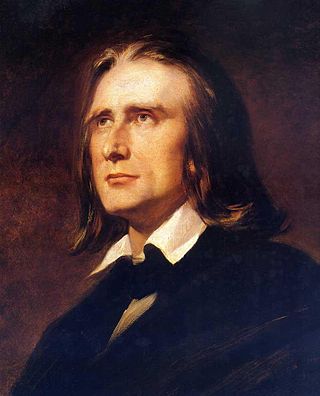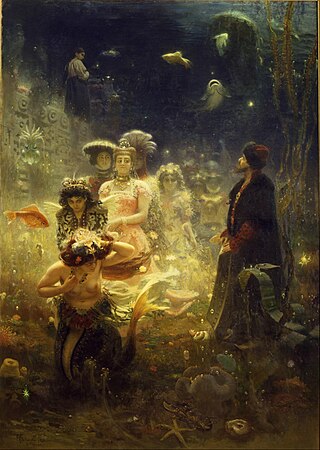A symphonic poem or tone poem is a piece of orchestral music, usually in a single continuous movement, which illustrates or evokes the content of a poem, short story, novel, painting, landscape, or other (non-musical) source. The German term Tondichtung appears to have been first used by the composer Carl Loewe in 1828. The Hungarian composer Franz Liszt first applied the term Symphonische Dichtung to his 13 works in this vein, which commenced in 1848.

Joseph Joachim Raff was a German-Swiss composer, pedagogue and pianist.

Paul Marie Théodore Vincent d'Indy was a French composer and teacher. His influence as a teacher, in particular, was considerable. He was a co-founder of the Schola Cantorum de Paris and also taught at the Paris Conservatoire. His students included Albéric Magnard, Albert Roussel, Arthur Honegger, Darius Milhaud, Yvonne Rokseth, and Erik Satie, as well as Cole Porter.

Karl Tausig was a Polish virtuoso pianist, arranger and composer. He is generally regarded as Franz Liszt's most distinguished pupil and one of the greatest pianists of all time.

Augusta Mary Anne Holmès was a French composer of Irish descent. In 1871, Holmès became a French national and added the accent to her last name. She wrote the texts to almost all of her vocal music herself, including songs, oratorios, the libretto of her opera La Montagne noire and the programmatic poems for her symphonic poems including Irlande and Andromède.
A Faust Symphony in three character pictures, S.108, or simply the "Faust Symphony", is a choral symphony written by Hungarian composer Franz Liszt inspired by Johann Wolfgang von Goethe's drama, Faust. The symphony was premiered in Weimar on 5 September 1857, for the inauguration of the Goethe–Schiller Monument there.

Les préludes, S.97, is the third of Franz Liszt's thirteen symphonic poems. The music was composed between 1845 and 1854, and began as an overture to Liszt's choral cycle Les quatre élémens, then revised as a stand-alone concert overture, with a new title referring to a poem by Alphonse de Lamartine. Its premiere was on 23 February 1854, conducted by Liszt himself. The score was published in 1856 by Breitkopf & Härtel. Les préludes is the earliest example of an orchestral work entitled "Symphonic Poem".

The symphonic poems of the Hungarian composer Franz Liszt are a series of 13 orchestral works, numbered S.95–107. The first 12 were composed between 1848 and 1858 ; the last, Von der Wiege bis zum Grabe, followed in 1882. These works helped establish the genre of orchestral program music—compositions written to illustrate an extra-musical plan derived from a play, poem, painting or work of nature. They inspired the symphonic poems of Bedřich Smetana, Antonín Dvořák, Richard Strauss and others.

Franz Liszt composed his Prometheus in 1850, numbering it No. 5 in his cycle of symphonic poems when he revised it in 1855. The work is based on the Greek myth detailing the Titan Prometheus' theft of fire from the gods and is numbered S.99 in the Searle catalogue.

Sadko, Op. 5, is a Tableau musical, or Musical picture, by Nikolai Rimsky-Korsakov, written in 1867 and revised in 1869 and 1892. It is sometimes called the first symphonic poem written in Russia. It was first performed in 1867 at a concert of the Russian Musical Society (RMS), conducted by Mily Balakirev. Rimsky-Korsakov later wrote an opera of the same name which quotes freely from the earlier work. From the tone poem the composer quoted its most memorable passages in the opera, including the opening theme of the swelling sea, and other themes as leitmotifs – he himself set out to "utilize for this opera the material of my symphonic poem, and, in any event, to make use of its motives as leading motives for the opera".
Orpheus is a symphonic poem written by Franz Liszt in 1853–54. He numbered it No. 4 in the cycle of 12 he wrote during his time in Weimar, Germany. It was first performed on 16 February 1854, conducted by the composer, as an introduction to the first Weimar performance of Christoph Willibald Gluck's opera Orfeo ed Euridice. The performance helped celebrate the birthday of Weimar's Grand Duchess Maria Pavlovna, who was an amateur musician and a staunch supporter of Liszt at Weimar.
Although Franz Liszt provided opus numbers for some of his earlier works, they are rarely used today. Instead, his works are usually identified using one of two different cataloging schemes:
Mazeppa is a symphonic poem composed by Franz Liszt between the years 1851 to 1854 for orchestra. Mazeppa, S. 100, is the sixth in the cycle of twelve symphonic poems written during Liszt's time in Weimar, however a thirteenth composition was added to his collection in 1882. Mazeppa is based on the poem of the same title written by Victor Hugo in 1829. The work premiered at the Court Theatre in Weimar on April 16, 1854.
Poème symphonique may refer to:

A Hero's Song, Op. 111, B. 199, also called Heroic Song for Orchestra, is a symphonic poem for orchestra composed by Antonín Dvořák between August 4 and October 25, 1897. It was premiered in Vienna in on December 4, 1898, with Gustav Mahler conducting the Vienna Philharmonic, and was later published in Berlin in 1899. Unlike Dvořák's other symphonic poems, this work is not based upon a specific text, and it may have been intended to be autobiographical. The piece is mostly energetic and triumphant, but it includes a slower section containing a funeral march. A typical performance lasts approximately 22 minutes.
The orchestral song is a late romantic genre of classical music for solo voices and orchestra.
Les Djinns FWV 45 is a symphonic poem for piano and orchestra by César Franck.

"Erlkönig", Op. 1, D 328, is a Lied composed by Franz Schubert in 1815, which sets Johann Wolfgang von Goethe's poem of the same name. The singer takes the role of four characters — the narrator, a father, his small son, and the titular "Erlking", a supernatural creature who pursues the boy — each of whom exhibit different tessitura, harmonic and rhythmic characteristics. A technically challenging piece for both performers and accompanists, "Erlkönig" has been popular and acclaimed since its premiere in 1821, and has been described as one of the "commanding compositions of the century".










